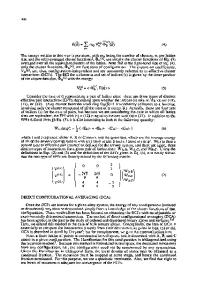The Role of Phase Stability in Ductile, Ordered B2 Intermetallics
- PDF / 197,020 Bytes
- 6 Pages / 612 x 792 pts (letter) Page_size
- 73 Downloads / 375 Views
0980-II06-10
The Role of Phase Stability in Ductile, Ordered B2 Intermetallics James R. Morris1,2, Yiying Ye3,4, Maja Krcmar5, and Chong Long Fu1 1 Materials Science & Technology Division, Oak Ridge National Laboratory, P.O. Box 2008, Oak Ridge, TN, 37831 2 Materials Science and Engineering, University of Tennessee, Knoxville, TN, 37996-2200 3 Ames Laboratory, Iowa State University, Ames, IA, 50011 4 Center of Analysis and Testing, Wuhan University, Hubei, Wuhan 430072, China, People's Republic of 5 Physics Department, Grand Valley State University, One Campus Drive, PAD 144, Allendale, MI, 49401-9403
ABSTRACT We discuss the underlying atomistic mechanism for experimentally observed large tensile ductility in various strongly ordered B2 intermetallic compounds. First-principles calculations demonstrate that all of the compounds exhibit little energy differences between the B2, B27 and B33 phases. These calculations relate observations of ductility in YAg, YCu and ZrCo to shapememory materials including NiTi. One transformation pathway between the B2 and B33 phases establishes a connection between this phase competition, and stacking faults on the {011}B2 plane. The low energy of such a stacking fault will lead to splitting of the b= dislocations into b/2 partials, observed in ZrCo, TiCo, and in the B19′ phase of NiTi. Calculations demonstrate that this pathway is competitive with the traditional pathway for NiTi. INTRODUCTION B2 intermetallics are common, and have attracted interest due to their strength, sometimes even at high temperatures. However, their room temperature polycrystalline ductility is often lacking. This may be due either to extrinsic effects, such as environmental embrittlement of the grain boundaries, or to intrinsic behavior. The Von Mises criterion for polycrystalline deformation requires five independent plastic deformation modes. It is usually considered unlikely that a material failing this criterion will show significant polycrystalline ductility. For B2 compounds, this usually indicates the need for slip, as the common slip mode is insufficient to satisfy the Von Mises criterion. However, the slip mode is rarely active in compounds with a high anti-phase boundary (APB) energy [1]. In recent years, there have been multiple reports of significant tensile ductility in highly ordered B2 compounds, including YAg and YCu [2], and ZrCo [3]. These ductilities are surprising, due to the fact that these are line compounds, and most such B2 intermetallics show very limited ductility, particularly in tension. These materials have limited deformation modes: for YAg and YCu, single crystal deformation along the axis produces a very high yield stress and little plastic deformation [4,5]. This is similar to the behavior of NiAl [6] which has poor polycrystalline room-temperature ductility.
[011]B2
Fig ½[100]
[100]B2 Fig. 1. (Left) Traditional description of B2 → B33 structure, as a special case of the B2 → B19′ transformation. At a particular angle, the body-centered orthorhombic B33 phase is formed.
Data Loading...











